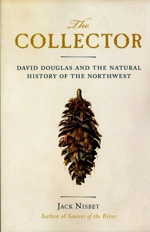The Collector: David Douglas and the Natural History of the Northwest
Review By David Brownstein
November 4, 2013
BC Studies no. 168 Winter 2010-2011 | p. 101
The Horticultural Society of London demanded that David Douglas (1799-1834), their employee and North American plant hunter, keep a meticulous journal of his travels. Certainly a better field naturalist than author, Douglas refused to let others transform his notes into a published narrative during his lifetime and was himself seemingly incapable of the task. Leaving much room for posthumous attempts, Jack Nisbet’s The Collector is the latest such effort, one primarily directed at a lay audience of nature and history enthusiasts. This book makes a number of unique contributions to an underdeveloped field, meaning that it is important reading for both the Douglas scholar and for students of the contact period in northwestern North America more generally.
A great strength of Nisbet’s book is that it gives even treatment to each of Douglas’s North American excursions, a consistent focus generally not duplicated in the existing literature, which tends to emphasize some trips over others. The book’s structure mirrors the seasons of Douglas’s travels and the intervening periods back in England. His first trip, in 1823, was to the eastern United States and Upper Canada, where he sought unfamiliar plants, new forest trees to replenish the dwindling homeland timber supply, and fruit trees for the society’s experimental orchard at Chiswick. His success prompted a second trip from 1825 to 1827. Supported by Hudson’s Bay Company transportation, resources, and hospitality, these three years of travel between the Columbia River Basin and York Factory represent a period that solidified Douglas’s reputation as they enabled him to describe and introduce more species to England than any other individual. Two subsequent years in that country, among the social and scientific elite, were very unhappy for a man of humble birth and limited learning. In 1830, Douglas undertook a third trip, which traversed the Columbia River Basin and California, and ended in 1834 in Hawaii, with his mysterious death. At the age of 35, Douglas’s gored and trampled body was found in a cattle pit, beneath a trapped bull.
The Collector is the latest in a succession of biographies, each an attempt to reconcile gaps in the historical record from different disciplinary perspectives. Douglas’s journal of his third expedition was destroyed while navigating the swollen Fraser River south of Fort George in 1833. Therefore, constructing a biography of the man has posed a profound challenge for subsequent generations: his life still awaits a definitive treatment. By the time that the renamed Royal Horticultural Society attempted to publish the extant journals, seventy years after Douglas’s death, the handwriting was hard to read and was made worse by faded ink. A poorly edited version was finally shared with the world in 1914 at a time when attention was focused on more pressing geopolitical matters. Vancouver barrister and city councillor Althelstan George Harvey wrote Douglas of the Fir in 1947, the most academic attempt to date, including citations. Since that time, Scottish forester John Davies compiled Douglas of the Forests in 1979, a close transcription of the journals with minor commentary; and Scottish writer Ann Lindsay Mitchell collaborated with forester and fellow countryman Syd House to produce the 1999 book David Douglas: Explorer and Botanist. All these texts must be read together if they are to provide insight.
The Collector reflects Nisbet’s background as an engaging naturalist and successful author. In this regard he duplicates his previous projects on explorer David Thompson and the several volumes he has written on the Columbia Plateau. Here, the well-crafted prose can leave one mentally out of breath as swaths of the book present an uninterrupted chronological flow from Douglas’s published journal. The result is a meticulously researched book, but one in which the reader must intuit any commentary on the role of David Douglas as Douglas’s and Nisbet’s voices intertwine to the point where they are virtually indistinguishable. While Nisbet is at his best when exploring the details of natural history, he is more muted regarding the meaning of his historical narrative.
Previous biographies present Douglas only as a botanist. The Collector wonderfully counters this perception by communicating the full breadth of Douglas’s scientific activity as a natural historian, documenting his work on birds, mammals, minerals, mountaineering, surveying, and ethnography. This wider narrative is not only a better reflection of Douglas’s North American activities but also a genuine scholarly contribution. Nisbet obliquely hints that, over the course of his career, Douglas transformed his specimen-collecting practices in order to deploy some late-life training in the use of astronomical and cartographic instruments so that he could illuminate the geographical distribution of plants. This change is described in pieces over the course of the book, but it is never recognized as an important observation.
Nisbet’s narrative provides insight into flora and fauna at the time of contact, Native resource management techniques, and fur trade relationships between Natives and newcomers. The Collectorwill be enjoyed most by those already familiar with the territory over which David Douglas travelled, but it will also be of interest to engaged readers who, in light of the current literature, are willing to pick up the pieces that Nisbet has assembled and run with them.
The Collector: David Douglas and the Natural History of the Northwest by Jack Nisbet
Seattle: Sasquatch Books 2009. 288 pp $23.95 cloth

